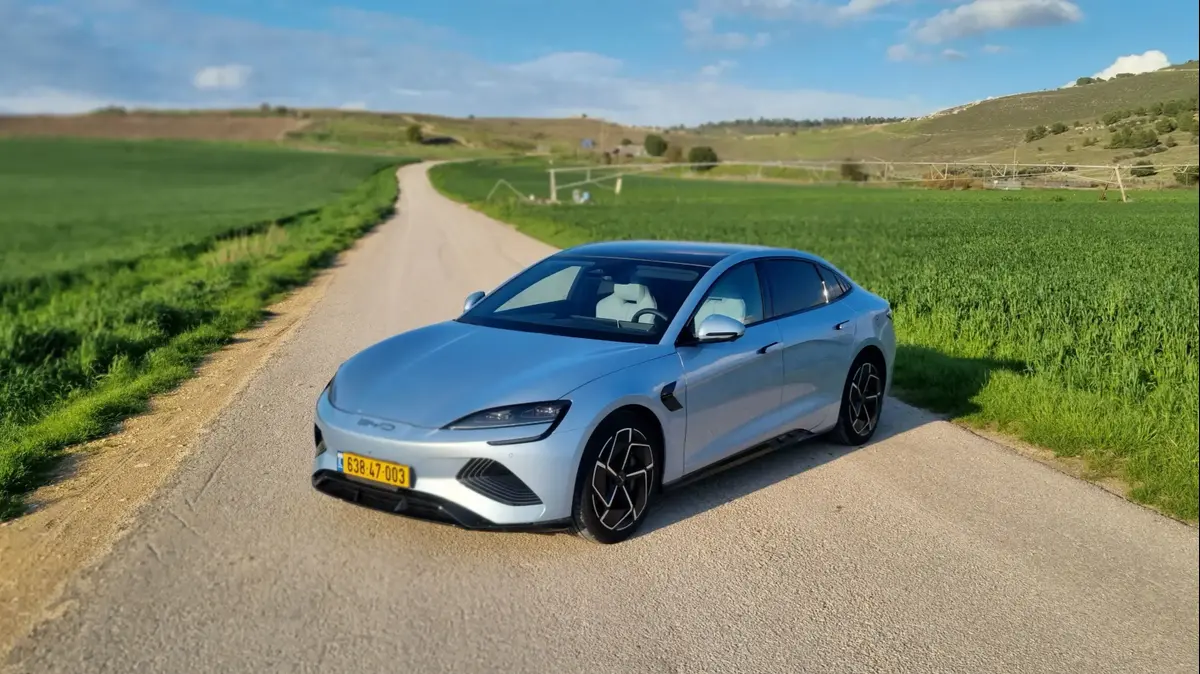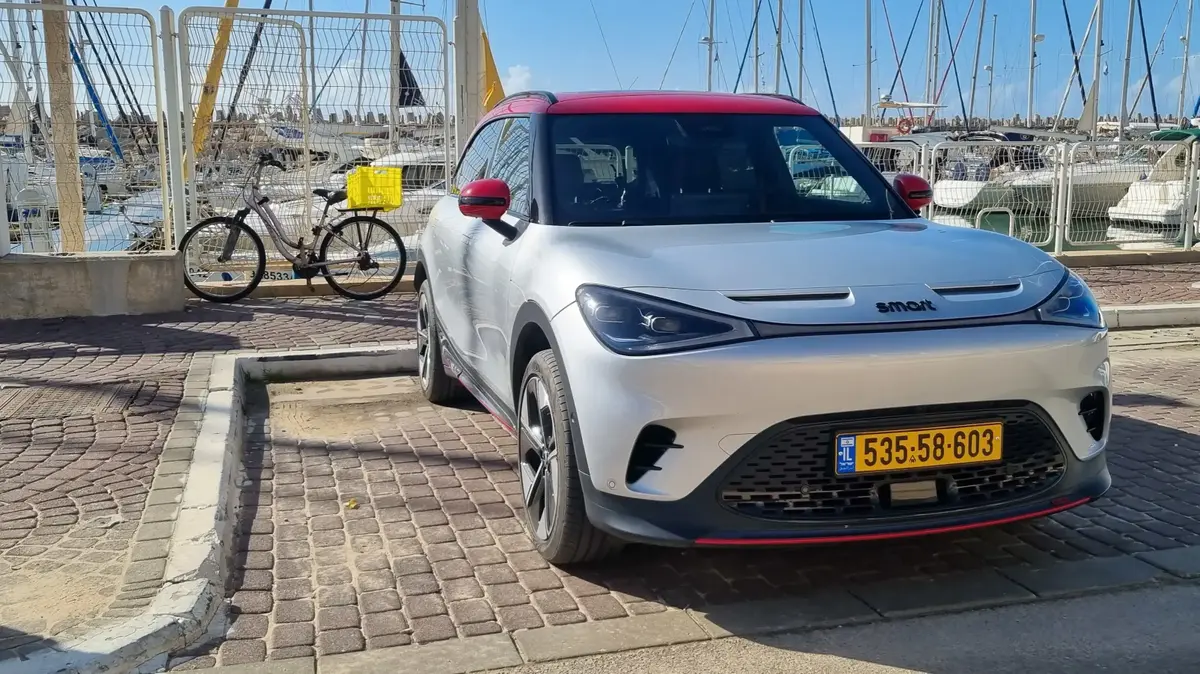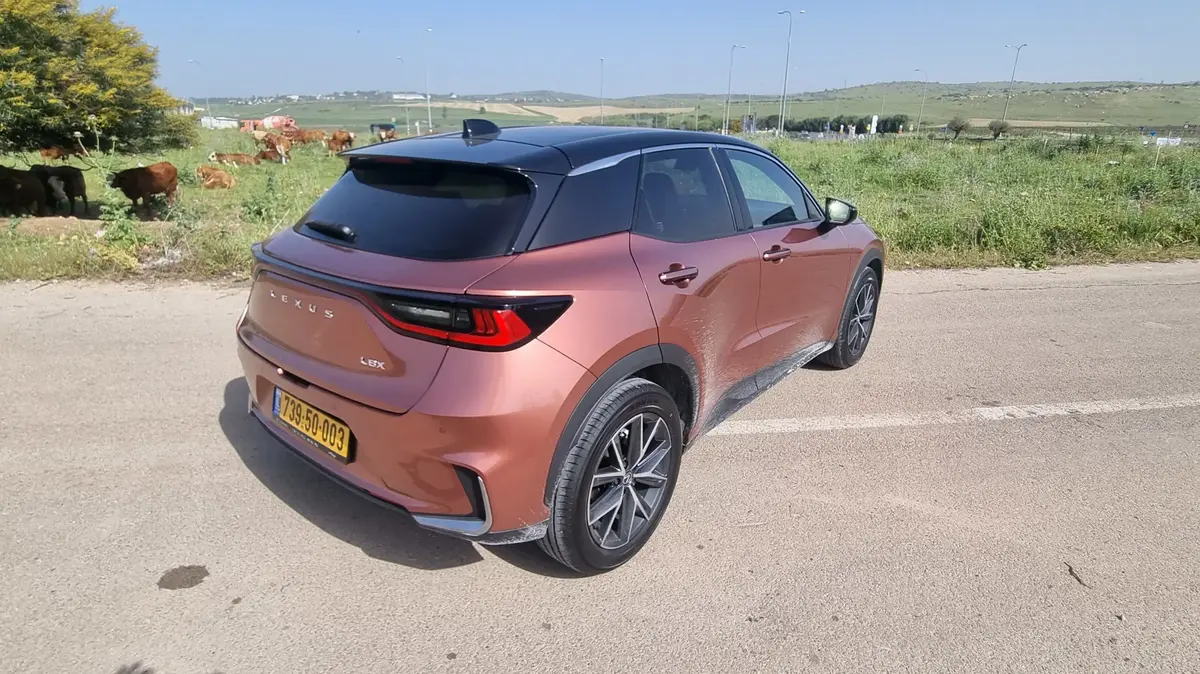vehicle
Vehicle tests
Road test: Mercedes EQC, the tram from Stuttgart
Two years after its introduction in Europe and a year after the acclimatization of competitors Jaguar I-Pace and Audi e-tron in Israel, the first swallow of Mercedes, the EQC 400, lands here. Did the delay make it good?
Tags
Mercedes
Crossover
electric car
electric car
Colmobil
Rami Gilboa
Monday, 02 November 2020, 09:50
Share on Facebook
Share on WhatsApp
Share on general
Share on general
Share on Twitter
Share on Email
0 comments
The design is modern and clean, but calmer than usual in the segment
The electric-hybrid market is booming, new models are landing with us with playful frequency.
The price range of trams in Israel ranges from NIS 130,000 to NIS 1,600,000, and today the first Mercedes tram arrives here.
This is the electric equivalent EQC 400 to the old GLC and also based on it, in the price range between 500 and 590 thousand shekels - reducing the tax benefits at the beginning of 2021 jumped the prices of trams into territory higher than they were before.
The test vehicle in the Electric ART level costs NIS 540,000.
More on Walla!
NEWS
Launch: Mercedes EQC
To the full article
technology
Unlike some of its competitors, Mercedes has not yet developed a dedicated EV platform for the electric vehicle;
EQC is based on the traditional GLC, and is externally similar to it.
The lack of an EV platform is reflected in the EQC's high curb weight, no less than 2,495 kilograms - that’s 625 kilograms more than the GLC AMG, for example.
This overweight does not prevent the EQC from accelerating from standstill to 100 km / h in 5.1 seconds at very fast speeds, and declaring a pretentious driving range of 412 kilometers - this with the help of two electric motors that provide 408 hp and 77.5 kg, and a battery Lithium-ion 80 kilowatts / hour.The front engine is charged for a calm and routine ride, the rear gives the extra power needed for extreme accelerations.In the
world of Mercedes, the letters EQ represent "artificial electric intelligence", a pun on the psychological term IQ. Computers and information processors that enable maximum utilization of electric propulsion, and the operation of sophisticated safety systems.The list of safety equipment includes autonomous distance and emergency braking (including cross or cross traffic), guarding and crossing a lane, dead space alert, shortening the tarpaulin. The adaptive and the maintenance of the travel route; these two functioned perfectly, providing us with security and relaxation.
If you were thinking of finding a front trunk, you were wrong - under the non-engine cover there is a technological tangle of batteries, relays, fans, and one small engine
Shows eyes
Just as the engineers relied on the GLC platform, so did the product designers.
The EQC has the same wheelbase as the GLC, but is 10 inches longer than it is;
These twins are almost identical.
EQC has undergone a design and aerodynamic upgrade but in a world of exciting crossovers, it has no design line or dramatic arrival effect.
20-inch rims decorated with an electric-blue shade stand out, how is it possible without?
The base version wears 19-inch rims, AMG boasts 21-inch rims.
The cabin is friendly to anyone who drives an up-to-date Mercedes, it's not bad at all.
The dashboard is controlled by two 10:25-inch digital monitors each, united behind a large and impressive glass surface.
The display is excellent and the monitors are MBB-friendly, but the huge glass surface reflects many light reflections, sometimes it is annoying.
The systems can be activated with the help of the touch screen, central mouse pad, physical buttons and the most amusing function of all, Hi, Mercedes "".
The air conditioner vents are decorated in a copper color, the steering wheel is thick and pleasant to the touch.
The driving position is good and the seats are supportive, although they are a bit stiff for my taste.
The materials and assembly are excellent on any scale with combinations of leather, aluminum, plastic, even recycled materials.
The space in the back is reasonable, though not the best there is.
The trunk contains 500 liters, there is no room left for a spare wheel.
Metallic blue is the favorite color of electric car designers
Disconnect from the shaker
The Mercedes EQC delivers the finest ride quality available, certainly in the compact crossover category.
It is quiet and comfortable despite the overly sporty tires, in the 50 section. At the rear there are non-adjustable air suspension that maintains a constant vehicle height.
The ride comfort is high but not perfect, bumpy roads manage to shake the chassis.
The acoustic insulation disconnects you from the sounds of the road and wind, and the electric motors are very quiet - you will need a particularly sensitive ear to notice the sounds of the motors and the hum of transmissions.
It is one of the most relaxed and luxurious cabins for a relaxed cruise, and the Burmester sound system complements the pleasure specifications.
The jump is instantaneous and kicks, as is customary in luxury electric cars.
Full pressure on the pedal launches the EQC aggressively and very quickly you start to reduce the intensity of the presses, it's just unpleasant.
The intermediate accelerations are very impressive and within the legal speed range you are just waiting for indirect opportunities, to savor the sudden leap.
At three-digit speeds, the acceleration calms down, but still, the instantaneous does not stop impressing you - you have not yet had time to press the pedal, and the engines have already blown you forward.
The cabin is spacious and needless to say - very high quality
Selecting the maximum regeneration mode (charging the battery with the help of the braking energy) will cause the electric Mercedes to brake hard in each relaxation from the pedal;
In sporty driving it is nice and very useful.
The Mercedes accelerates slightly better than the Audi, Jaguar and faster than both.
Electric luxury vehicles create a world of instant and tremendous accelerations, unfamiliar to gasoline or diesel drivers.
Road behavior?
Let's not exaggerate expectations, yet we are dealing with two and a half tons.
Tire grip is high but the steering is not sharp and the car is not keen on diving for sharp turns.
Acceleration into a turn will produce heavy understeer, and braking is not impressive for a vehicle costing half a million shekels.
But it is likely that the classic EQC customer will not feel these nuances, he is not preying on driving roads for breakfast.
Whoever buys such a vehicle will be completely dissatisfied with the dynamic capabilities of the EQC, we are not in the frenetic world of AMG real.
The back seat is comfortable, but the space is not plentiful
The energy crisis
In the world of trams we drive more relaxed, set cruise control on 120, and let the vehicle roll towards the planned charging point.
Do not expect the declared range of 400 kilometers to charge, I guess you will start looking for a charging point already at 300 - this is also more than the daily range required by most of us.
The Mercedes learns your driving style, and displays the expected driving range accordingly;
In my case the declared range was 330 miles, it could also go down.
To go 400 kilometers on one charge you have to work on it - drive the calmest in the world, 80-90 km / h, who cares?
What is important for all of us to internalize is that an electric vehicle does not allow spontaneity of an internal combustion engine. You must know what is planned For the rest of the day, and there is no option to suddenly jump to another and distant destination.How many times a month do you drive over 300 miles a day? Very little, but in my case it happens more often.
The look is very reminiscent of the GLC, on which the EQC is based
I will emphasize in advance that the next discussion is not technological, and an organized person has no problem getting by with 300 miles a day;
On the few occasions when it requires a longer range it will take the second family car, a regular car that has no electric ‘range anxiety’.
The problem lies in the personality traits of the driver - take me for example, a spontaneous and impulsive guy, who likes to check limits and limitations.
For the first day of the test I set out with a declared range of 292 miles.
I planned to make some arrangements, drive north through the valley, sample Ma'ale Gilboa and continue to the Afcon charging station, at the Mahnayim junction.
I planned so, but my right leg wanted something different.
I drove a little farther, a little faster, and suddenly the trip computer showed a range of 95 miles, while the Wise claims that the distance to the destination is 110 miles ... The cabin pressure started to go up, the range shrank, and I started taking contraception;
I selected ECO mode, lowered speed and accelerations, on one of the descents from the mountain I used regenerative braking to add 15 miles to the declared range.
The ascent from the Beit She'an Valley dried up the battery until I had to lower my speed to 70 km / h, and turn off the air conditioner ... The emergency measures added a few kilometers to me and I already arrived at the charging station with 12 spare kilometers and 5% battery. , Because there is no way to charge an electric vehicle that gets stuck on the side of the road: no starting with cables, no jerkins of electricity.The only solution is to order a tow truck or a yasur helicopter, I do not like it.
On the right, a gas station that will get you going in seconds, on the left the carcass of the Better Place battery replacement station on the same idea, in the middle, a charging time of 45 minutes from a very fast position
Time passes lazily
To charge the battery for a safe return to the center, I had to linger for about 45 minutes at the fast charging station in the dents, with a power of 175 kilowatts;
Mercedes' charging capacity is limited to 110 kilowatt-hours but that was enough to reach 97% in 56 minutes.
Technologically, this is very impressive, but it turns out that even the fastest charging station in Israel needed close to an hour, to replace a traditional refueling that takes a few minutes.
In slower positions it would last twice as long, this household sediment would take close to ten hours.
My problem was lack of planning and self-discipline, and I take on ministerial responsibility;
But even after dozens of fast charging stations are operated in Israel, a long drive may require you to park for 30-20 minutes.
For me it was an intriguing experience and a good story to write;
For a businessman who invested half a million shekels in the latest technology bomb, it might be less entertaining.
The information about the flow of energy comes in numbers, type and colors
The consolation is that already today hundreds of charging stations are installed in the country, the fastest has an 'ultra' power of 175 kilowatts.
There are a handful of such stations (of Afcon), but the installations are progressing fast.
There are dozens of other 'fast' stations of the Ginergy company (and others) with a capacity of 50 kilowatts, they will charge half a battery in less than an hour.
Keep in mind that these stations do not replace the gas station, this is what the home charging station does.
Public charging stations are likened to an electric 'boost' you need on the road, like charging a smartphone during a lunch break.
Charging prices vary greatly;
A home charge for an 80 kilowatt battery costs about 45 shekels (a quarter or a fifth of a gasoline refill for such a range), 60-70 shekels at 50 kilowatt stations, around 160 shekels at a 175 kilowatt station.
You will usually need a partial refill and the cost will be lower, respectively.
Less adventurous in design than its competitors
Back to the home port
On my way home I set up cruise control and while the Sixties songs flooded the cabin, I was able to sum up the experience.
The little adventure on the way to the camps was a direct result of my misconduct, and it would also have occurred with another electric vehicle, basic or luxurious.
The event highlights the inadequacy of current electric cars to an overly hectic and spontaneous lifestyle.
If this is your personal profile or you have frequent occupations in Rosh Pina or Mitzpe Ramon, it is better for you to buy a gasoline or diesel car;
On the way you will save 100,000 shekels, or more, which by the way will buy you gallons upon gallons of fuel.
More on Walla!
NEWS
Road test: Mercedes AMG A45S
To the full article
But if your lifestyle is less hectic, your daily commute amounts to around 250 miles per day and you are already eager to move into the premium-electric era, the Mercedes EQC could be a great opportunity.
The EQC does not attract much attention, it is heavy, but its qualities are high and well focused.
The electric motors provide intoxicating accelerations and impressive operational quiet.
The cabin is high quality and luxurious, supported by a wealth of technology and fine safety systems.
The EQC is not sporty but it is very fast, its accelerations are dizzying and in the end - it offers a very useful driving range, for the vast majority of Israelis.
While we waited for EQC, about 120 Jaguar I-Pace and 650 Audi e-tron were sold in Israel, which took full advantage of the tax benefits of 2019. Mercedes brought its tram after the abolition of the tax benefits, but the product is fine and polished, in the best tradition of the Stuttgart manufacturer.
I have no doubt we will see more and more of these cars on the road, look for the blue rims.
The most advanced is the most lucrative
Compulsory insurance starting at NIS 54 per month
By the insurance company WE SURE
Purchase >>
On the technical side: Mercedes EQC400 Electric ART
Engine, propulsion:
electric, dual
Battery:
lithium-ion 80 kW / h
Power (hp):
408
Torque (kg):
77.5
Transmission:
Direct transmission ratio (1 speed)
Declared range:
412 km
Test Range:
300-340 km
Length
Dimensions
(cm):
476.1
Width (cm):
188.4
Height (cm):
162.3
Wheelbase (cm)
: 287.3
Trunk volume:
500 liters
Weight (kg):
2,495
Acceleration
performance
0-100 (seconds): 5.1
Maximum speed (km / h):
180 (electronically limited)
Competitors:
Audi e-tron, Jaguar i-Pace
Price:
NIS 500,000 (base) NIS 540,000 (test)
Share on Facebook
Share on WhatsApp
Share on general
Share on general
Share on Twitter
Share on Email
0 comments















